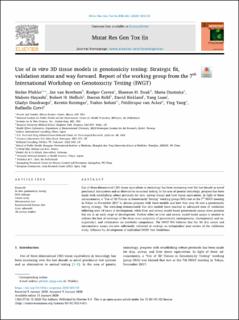| dc.contributor.author | Pfuhler, Stefan | |
| dc.contributor.author | van Benthem, Jan | |
| dc.contributor.author | Curren, Rodger | |
| dc.contributor.author | Doak, Shareen H. | |
| dc.contributor.author | Dusinska, Maria | |
| dc.contributor.author | Hayashi, Makoto | |
| dc.contributor.author | Heflich, Robert H. | |
| dc.contributor.author | Kidd, Darren | |
| dc.contributor.author | Kirkland, David | |
| dc.contributor.author | Luan, Yang | |
| dc.contributor.author | Ouedraogo, Gladys | |
| dc.contributor.author | Reisinger, Kerstin | |
| dc.contributor.author | Sofuni, Toshio | |
| dc.contributor.author | van Acker, Frederique | |
| dc.contributor.author | Yang, Ying | |
| dc.contributor.author | Corvi, Raffaella | |
| dc.date.accessioned | 2020-04-07T07:24:45Z | |
| dc.date.available | 2020-04-07T07:24:45Z | |
| dc.date.created | 2020-04-06T13:59:51Z | |
| dc.date.issued | 2020 | |
| dc.identifier.citation | Mutation Research. Genetic Toxicology and Environmental Mutagenesis. 2020, 850-851 . | en_US |
| dc.identifier.issn | 1383-5718 | |
| dc.identifier.uri | https://hdl.handle.net/11250/2650569 | |
| dc.description.abstract | Use of three-dimensional (3D) tissue equivalents in toxicology has been increasing over the last decade as novel preclinical test systems and as alternatives to animal testing. In the area of genetic toxicology, progress has been made with establishing robust protocols for skin, airway (lung) and liver tissue equivalents. In light of these advancements, a “Use of 3D Tissues in Genotoxicity Testing” working group (WG) met at the 7th IWGT meeting in Tokyo in November 2017 to discuss progress with these models and how they may fit into a genotoxicity testing strategy. The workshop demonstrated that skin models have reached an advanced state of validation following over 10 years of development, while liver and airway model-based genotoxicity assays show promise but are at an early stage of development. Further effort in liver and airway model-based assays is needed to address the lack of coverage of the three main endpoints of genotoxicity (mutagenicity, clastogenicity and aneugenicity), and information on metabolic competence. The IWGT WG believes that the 3D skin comet and micronucleus assays are now sufficiently validated to undergo an independent peer review of the validation study, followed by development of individual OECD Test Guidelines. | en_US |
| dc.language.iso | eng | en_US |
| dc.rights | Attribution-NonCommercial-NoDerivatives 4.0 Internasjonal | * |
| dc.rights.uri | http://creativecommons.org/licenses/by-nc-nd/4.0/deed.no | * |
| dc.title | Use of in vitro 3D tissue models in genotoxicity testing: Strategic fit, validation status and way forward. Report of the working group from the 7th International Workshop on Genotoxicity Testing (IWGT) | en_US |
| dc.type | Peer reviewed | en_US |
| dc.type | Journal article | en_US |
| dc.description.version | publishedVersion | en_US |
| dc.rights.holder | © 2020 The Authors. Published by Elsevier B.V. | en_US |
| dc.source.pagenumber | 10 | en_US |
| dc.source.volume | 850-851 | en_US |
| dc.source.journal | Mutation Research. Genetic Toxicology and Environmental Mutagenesis | en_US |
| dc.identifier.doi | 10.1016/j.mrgentox.2020.503135 | |
| dc.identifier.cristin | 1805431 | |
| dc.relation.project | NILU: 117029 | en_US |
| cristin.ispublished | true | |
| cristin.fulltext | original | |
| cristin.qualitycode | 1 | |

